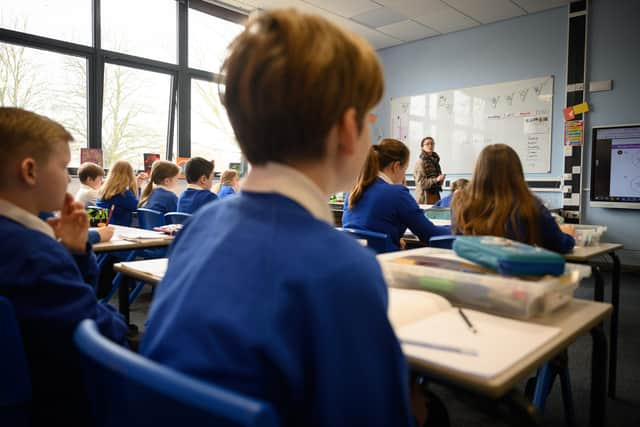Pupils face prospect of bubbles in new term in effort to blunt Omricon spread
and live on Freeview channel 276
New guidance issued by the Scottish Government states schools should adopt a “strengthened approach” to minimising contacts, with the reintroduction of groupings where practical.
The size of the groups will be determined by individual head teachers and local authorities, but the guidance states that it could span an entire year group, or senior phase, in secondary school.
Advertisement
Hide AdAdvertisement
Hide AdIt is one of a series of measures designed to curb Covid-19 infection rates across the school estate in light of the rapidly spreading Omicron variant.
The Government said some measures that were previously relaxed are being introduced next month, with a pressing need for staff to “strictly follow” existing safety mitigations.
Other measures outlined in the revised guidance includes a “strengthened approach” to self-isolation for household contacts of positive cases, tightened restrictions on school visitors, and updated guidance on regular ventilation and CO2 monitoring.
The guidance also refers to a need for an increased uptake of regular asymptomatic testing, and a requirement for schools and local authorities to provide essential support for particular groups, including vulnerable children and young people, in the event of temporary school closures at a local level.


Advertisement
Hide AdAdvertisement
Hide AdThe Government has said local authorities and schools should implement the changes as soon as they can from the start of the January term.
Education secretary Shirley-Anne Somerville said: “Throughout the pandemic, our priority has been to keep our children, young people and staff safe. These changes reflect the threat presented by the rapid spread of the Omicron variant, and they will be reviewed on an ongoing basis.
“The updated guidance has been informed by advice from the advisory subgroup on education and children’s issues and senior clinicians, based on the latest public health assessment of the situation, with input from the Covid-19 education recovery group.”
She added: “In addition to the changes, it’s more important than ever that safety measures already in place in schools are strictly followed. These include physical distancing, one-way systems and the correct use of face coverings.”
Advertisement
Hide AdAdvertisement
Hide AdAbout 26,500 Covid-related absences were recorded across Scottish schools on Monday, up from around 12,000 on November 29. It is the highest non-attendance figure seen in three months.
General secretary of the NASUWT teaching union, Dr Patrick Roach, said on the new guidance:“The weak guidance on ventilation will be of particular concern to teachers and school leaders, given the strong scientific evidence indicating the need for more investment to be made in the provision of CO2 monitors and air purifiers.
“Encouraging uptake of twice weekly asymptomatic testing among pupils does not guarantee that these tests will be undertaken.
“Funding from the Government for additional on-site testing for pupils would be a more effective way of ensuring that all pupils are regularly tested during this period of high Covid prevalence.
Advertisement
Hide AdAdvertisement
Hide Ad“It is difficult to square the enhanced measures on self-isolation that were recently introduced for the general population with the introduction of a ‘voluntary’ exemption from self-isolation for workers in schools.
“The Government must explain how they will ensure that teachers who should be self-isolating are not placed under pressure to return to the workplace prematurely, which could put others at risk.”
A message from the editor:
Thank you for reading this article. We're more reliant on your support than ever as the shift in consumer habits brought about by coronavirus impacts our advertisers. If you haven't already, please consider supporting our trusted, fact-checked journalism by taking out a digital subscription.
Comment Guidelines
National World encourages reader discussion on our stories. User feedback, insights and back-and-forth exchanges add a rich layer of context to reporting. Please review our Community Guidelines before commenting.
